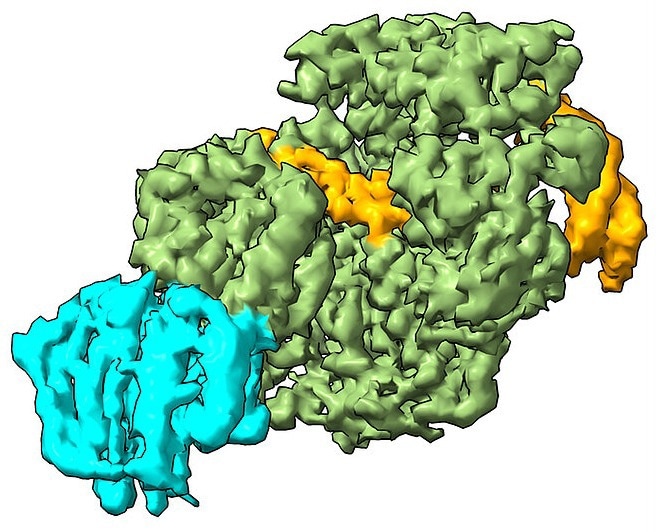Researchers at the University of Würzburg uncovered the way the protein XPD recognizes severe DNA damage and regulates its repair.
 The figure shows the experimental data derived from the cryo EM experiments as a 3D reconstruction. The XPD protein is depicted in green, the accessory factor p44 in cyan, and the damaged DNA is shown in orange. The data provides information up to 3.1 Å (one Å corresponds to one hundred-millionth of a centimeter) resolution, allowing to observe atomic details of XPDs interaction with the damaged DNA. Image Credit: Jochen Kuper/JMU
The figure shows the experimental data derived from the cryo EM experiments as a 3D reconstruction. The XPD protein is depicted in green, the accessory factor p44 in cyan, and the damaged DNA is shown in orange. The data provides information up to 3.1 Å (one Å corresponds to one hundred-millionth of a centimeter) resolution, allowing to observe atomic details of XPDs interaction with the damaged DNA. Image Credit: Jochen Kuper/JMU
Nucleotide excision repair (NER), the body's own “DNA repair team,” is largely composed of the XPD protein. Similar to a canine nose, NER identifies specific damage sites, locates the damaged DNA, and enlists the aid of additional repair proteins to remove and replace the faulty regions. By identifying and repairing UV-damaged DNA, XPD, for instance, stops skin cancer from developing in healthy individuals.
For the first time, a group of scientists at the University of Würzburg (JMU) has figured out precisely how the XPD protein can identify and confirm the existence of DNA damage. Together with chemist Claudia Höbartner from the Department of Organic Chemistry, the team was led by biochemist Caroline Kisker, Chair of Structural Biology at the Rudolf Virchow Center in Würzburg.
Study of Severe DNA Damage
The Würzburg team focused on how the XPD protein works in interstrand crosslinking – one of the most severe forms of DNA damage known. It is caused, for example, by environmental toxins and industrial chemicals.
Interstrand crosslinking causes DNA to be incorrectly copied and read during cell division. This leads to genetic damage that can trigger cancer.”
Caroline Kisker, Biochemist and Chair, Department of Structural Biology, Rudolf Virchow Center
In their study, the scientists used cryo-electron microscopy to analyze how XPD unwinds the double helix of DNA to reveal the defective sites of interstrand cross-linking, and created a model of how the damage is detected and removed.
The findings from our work provide the basis for new approaches to treating various types of cancer. By specifically weakening repair mechanisms such as NER in cancer cells, we could significantly increase the effectiveness of drugs.”
Jochen Kuper, Rudolf Virchow Center
The research team intends to look into how XPD recognizes different kinds of DNA damage in future studies. German Cancer Aid and the German Research Foundation (DFG) provided funding for the study.
Source:
Journal reference:
Kuper, J., et al. (2024) XPD stalled on cross-linked DNA provides insight into damage verification. Nature Structural & Molecular Biology. doi.org/10.1038/s41594-024-01323-5